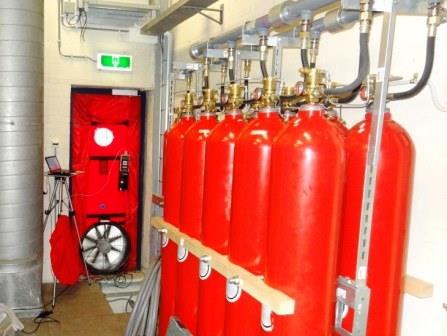Many server room integrity test failures are caused by the inability of the server room’s envelope to adequately retain the extinguishant. Due to penetrations through the wall, ceiling and floors the enclosure is not able to retain the extinguishant agent for the required holding period – usually 10 minutes. If the server room fails the integrity test, remedial work should then be undertaken to reduce the leakage from the enclosures envelope, this may include;
- Sealing the underside of doorways within the floor void (Risk Level 10)
- Sealing all cracks or penetrations leading into or out of the protected enclosure (Risk Level 8)
- If a false ceiling is installed below the structural soffit, ensure the air tightness line – usually above the false ceiling is fully sealed. (Risk Level 10)
- Ensure all structural steels are sealed where they go through the inner envelope (Risk Level 8)
- Seal around the all air conditioning/cooling vent frames (Risk Level 8)
- Sealing all pipe chases and cable trays to be sealed around the outside and inside where they penetrate the perimeter boundaries of the protected enclosure (Risk Level 10)
- Walls to be caulked around the inside perimeter at both high and low level (Risk Level 9)
- Sealing of porous block walls – this can be remedied by painting etc. (Risk Level 8)
- The addition of door sweeps or drop seals, weather stripping around jambs (Risk Level 9)
- Sealing of windows/glazed sections to the area (Risk Level 8)
In the event of a failed server room enclosure test we can quickly locate the air leakage paths using low impact smoke-puffers – if permitted.
We can then issue an air leakage report highlighting the air leakage paths within the server room enclosure. This will ensure that you have all of the required information to undertake targeted remedial sealing works on the enclosure prior to the final room integrity test.
Once the air leakage paths are sealed a second integrity test can be undertaken – if time permits. Once the appropriate remedial work has been undertaken then the enclosure should be retested to confirm if an acceptable level of integrity has been reached and the results recorded.

If the server room fails the enclosure test, a formal report can be issued detailing the results and any recommendations. The failure report should be retained for regulatory authority/ insurer’s reference. We can also undertake the remedial sealing works for you resulting in a ‘one stop’ solution for all your integrity testing requirements. Due to the importance of these areas; we also offer an ‘out of hours’ service as we understand the impact/cost of closing down areas such as server/turbine rooms etc. during peak hour usage.
References
- Gaseous Fire Extinguishing Systems (2000)
- NFPA 2001 Clean Agent Fire Extinguishing Systems (2000) BS EN:ISO 14520
- EU Regulation 2037/2000 (26/6/00)
- BFPSA Code of Practice for Gaseous Fire Fighting Systems
- LPC Recommendations for Loss Prevention in EDP Installations
We can set up a yearly testing regime to ensure you comply with the relevant standards such as BS14520 & NFPA 2001; we will even contact you to remind you that your test/s are due.
If you require any further details on preparing for your room integrity test, please visit download our room integrity checklist. Or if you would like more information on our server room integrity test services please contact us at: info@aptsoundtesting.co.uk or call Darren direct on 07775623464.
